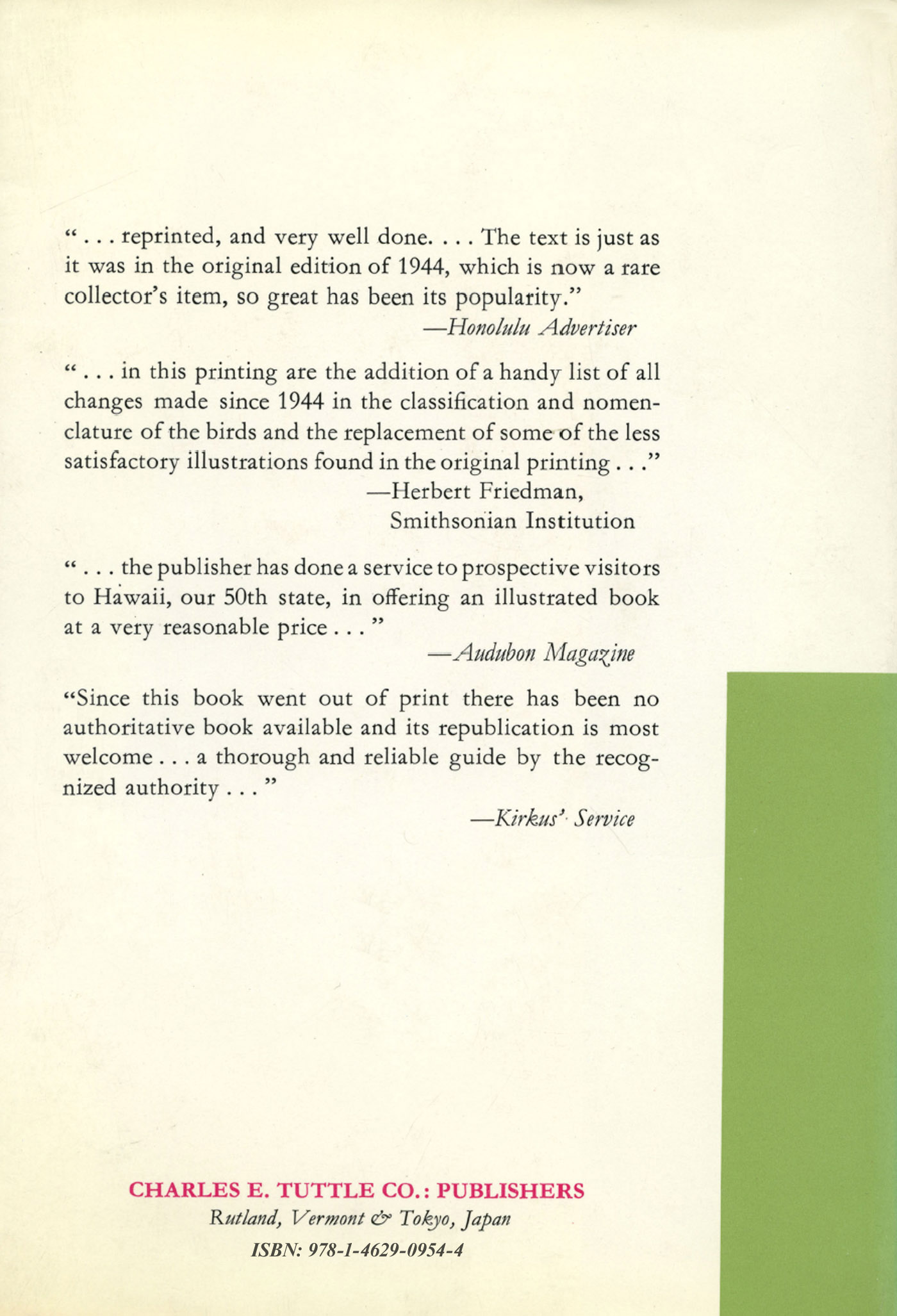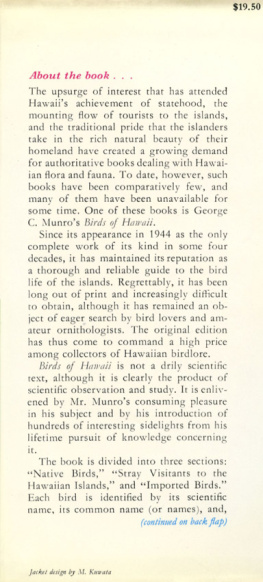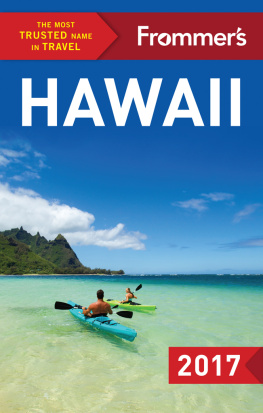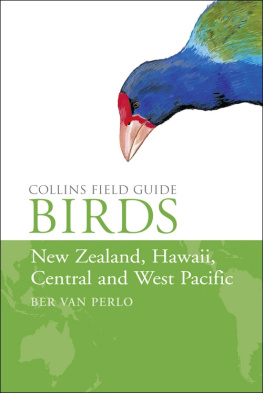Munro - Birds of Hawaii
Here you can read online Munro - Birds of Hawaii full text of the book (entire story) in english for free. Download pdf and epub, get meaning, cover and reviews about this ebook. year: 1989, publisher: Tuttle Publishing, genre: Detective and thriller. Description of the work, (preface) as well as reviews are available. Best literature library LitArk.com created for fans of good reading and offers a wide selection of genres:
Romance novel
Science fiction
Adventure
Detective
Science
History
Home and family
Prose
Art
Politics
Computer
Non-fiction
Religion
Business
Children
Humor
Choose a favorite category and find really read worthwhile books. Enjoy immersion in the world of imagination, feel the emotions of the characters or learn something new for yourself, make an fascinating discovery.
- Book:Birds of Hawaii
- Author:
- Publisher:Tuttle Publishing
- Genre:
- Year:1989
- Rating:5 / 5
- Favourites:Add to favourites
- Your mark:
- 100
- 1
- 2
- 3
- 4
- 5
Birds of Hawaii: summary, description and annotation
We offer to read an annotation, description, summary or preface (depends on what the author of the book "Birds of Hawaii" wrote himself). If you haven't found the necessary information about the book — write in the comments, we will try to find it.
Munro: author's other books
Who wrote Birds of Hawaii? Find out the surname, the name of the author of the book and a list of all author's works by series.
Birds of Hawaii — read online for free the complete book (whole text) full work
Below is the text of the book, divided by pages. System saving the place of the last page read, allows you to conveniently read the book "Birds of Hawaii" online for free, without having to search again every time where you left off. Put a bookmark, and you can go to the page where you finished reading at any time.
Font size:
Interval:
Bookmark:
Acknowledgment
I wish to acknowledge my indebtedness to Winifred Derby Robertson, whose extensive knowledge of books and command of language enabled her to give splendid cooperation as collaborator in the composition of this work and invaluable assistance for its successful completion. She has read my first drafts, made corrections, suggested improvements and contributed choice portions of her own, gave encouragement when difficulties loomed and spirits flagged, and assisted generally.

Native Hawaiian Birds
SEA BIRDS
Against the illimitable blue of the sky, over the unfathomable blue of the ocean the sea birds of the Pacific wing the cycle of their lives. For them the ocean is a larder: the islands and atolls their mating ground and nurseries. In the air on the wing what can compare with the wild majesty of the giant albatross riding the air currents with effortless ease, wide pinions spread as the bird glides and swoops against the sun. The plummeting dive of the gannets upon their fishy prey, the dipping sweep of the shearwaters close to the sparkling wave, the bat-like, fluttering of the tiny petrel, the vigorous flap flap of the booby returning to its nest, and the questing rise and fall of the white-tailed tropic bird against the cliff faces, all proclaim the species to the knowing eye.
First in the most recent classification of Hawaiian birds come members of the order of Petrels. The distinguishing features of this order are well defined viz. a strongly hooked bill covered with horny plates, and nostrils in tubes. The three front toes are fully webbed, hind toe small or absent.
There are ten species that range the ocean surrounding the Hawaiian group, and nest on islands of the Hawaiian Chain, on the large mountainous islands of the main group and small islands off their shores. Included in these species are birds of size as great as 33 inches long with a wing spread of over 7 feet and small birds not over 8 inches long. Two are albatrosses; three are shearwaters, less than half the size of the albatrosses; two are medium sized petrels; one, between the medium sized petrels and the storm petrels; and two storm petrels.
All these birds are undoubtedly surface feeders, the larger species flying all day and settling on the water at night to feed on squids and fishes that come to the surface at that time. Storm petrels generally pick up their food from the surface of the water as they skim the waves, some of them, using their feet to support them and seeming to walk on the water. The Hawaiian species can be seen to skim the surface and no doubt capture their food in the same way but cannot be studied closely as they do not follow ships as is the habit of some others. They only approach ships when attracted by their lights. The few I have examined had only a slimy substance and some little pieces of light pumice stone in their stomachs. It is generally supposed that most species of this order leave their young when full grown and very fat to finish their development alone, absorbing their fat and eventually following their parents to sea. It is more likely that the old birds return at long intervals and eventually conduct the young birds to the feeding grounds.
Some of these birds were found in countless numbers when man first came in contact with them. Their span of life must be very great as most of them lay but one egg a year and at times there is considerable mortality in the young. Many species will suffer unavoidable reduction in this war. When peace comes every effort should be made to encourage their recovery. Some of the species that nested on the larger islands are already on the verge of extinction through causes other than war. No effort should be spared to save these vanishing species.

White tern (Gygis alba rothschildi Hartert), from a photograph by Donald R. Dickey, Tanager Expedition, 1923.
Photo by courtesy of the Bishop Museum.

1. Black-footed Albatross
2. Laysan Albatross
3. I.aysan Albatross, Chick partly fledged

1. Pacific Golden Plover
2. Black-crowned Night Heron
3. Ruddy Turnstone
4. Sanderling
5. Australian Gallinule
ORDER PROCELLARIIFORMES
| DIOMEDEIDAE | Albatross Family |
BLACK-FOOTED ALBATROSS
| Diomedea nigripes Audubon | Plate 1, Fig. 1 |
Other names: Black Albatross; Brown Gooney; Gooney.
This bird, well-known on Midway and familiar to travelers from its habit of following vessels between the Northwest Mainland and Honolulu (it is the only sea bird in waters surrounding Hawaii to do so), is dark sooty brown above, lighter below; forehead generally dirty white, on some extending to the top of the head; the upper and lower tail-coverts of some are more or less white; the bill is dark brown; legs and feet black. Its length is about 33 inches with a wing spread of a little over 7 feet. There is little difference between the sexes or the immature and the old. Albinism has been noted and some observers think they have seen hybrids between this species and the Laysan albatross.
These birds come to breed on low sand islands of the Hawaiian Chain after ranging the North Pacific as far as. the Bering Sea. Individuals leg-banded on the Midway Islands, have been retaken off the coasts of Alaska, Oregon and Japan. They begin to arrive at the breeding grounds in the middle of October. They form colonies, generally on the strip of open sand above high water mark. They mate and build conical nests of sand amid a terrible din of various hoarse cries. One egg is laid on the mound of sand, Hadden states that it is the same as that of the Laysan albatross. They have a dance which is considered by observers to be faster and more graceful than that of the Laysan albatross which is famous and more widely known. The old birds leave before the middle of June and the young ones follow by the first of August, We took two male adults on July 18 which might.indicate that some old birds return to guide the young to their ocean range.
We of the Rothschild expedition had an exceptional opportunity to study this bird at sea, as individuals accompanied us most of the way to Midway and back to north of the 38th degree of Latitude about 400 miles from Honolulu. Our 45 ton schooner was low in the water and the birds came fearlessly up to the stern to tear lumps from the salt salmon or turtle flesh that the Captain kept hanging at the water's edge to attract sharks. We noted their remarkable power of flight in favorable wind, their preference for the water in calms, the querulous squeaking of the young birds when feeding, young birds trying to dive and old birds succeeding in going down several feet when the meat sank. Ashore we found only oil, cuttle fish bills and small stones in the stomachs of young birds. A fish about a foot long taken from the throat of an old bird, when offered to a large chick was eagerly swallowed.
LAYSAN ALBATROSS
| Diomedea immutabilis Rothschild | Plate 1, Figs. 2 & 3 |
Other names: White Albatross; White Gooney; Gooney.
This beautiful bird is almost pure white with a black patch in front of the eye; upper surface of wings blackish brown; tail black; bill gray; legs and feet fleshy pink Total length 32 inches. The sexes and young birds are similar in color. When nearly full fledged the young carry a tuff of down around the neck, giving them a peculiar appearance. The chick is covered with dark gray down. Two albinos on Lisiansky Island were striking birds. They were white with delicate pearl gray wings and tail. One was reported on Laysan as all pure white. It ranges the North Pacific to about 40 degrees of latitude. A young one banded on Midway was recaptured 300 miles off the coast of Japan. It breeds on most small islands of the Hawaiian Chain and sometimes on larger Niihau of the main group.
Font size:
Interval:
Bookmark:
Similar books «Birds of Hawaii»
Look at similar books to Birds of Hawaii. We have selected literature similar in name and meaning in the hope of providing readers with more options to find new, interesting, not yet read works.
Discussion, reviews of the book Birds of Hawaii and just readers' own opinions. Leave your comments, write what you think about the work, its meaning or the main characters. Specify what exactly you liked and what you didn't like, and why you think so.













